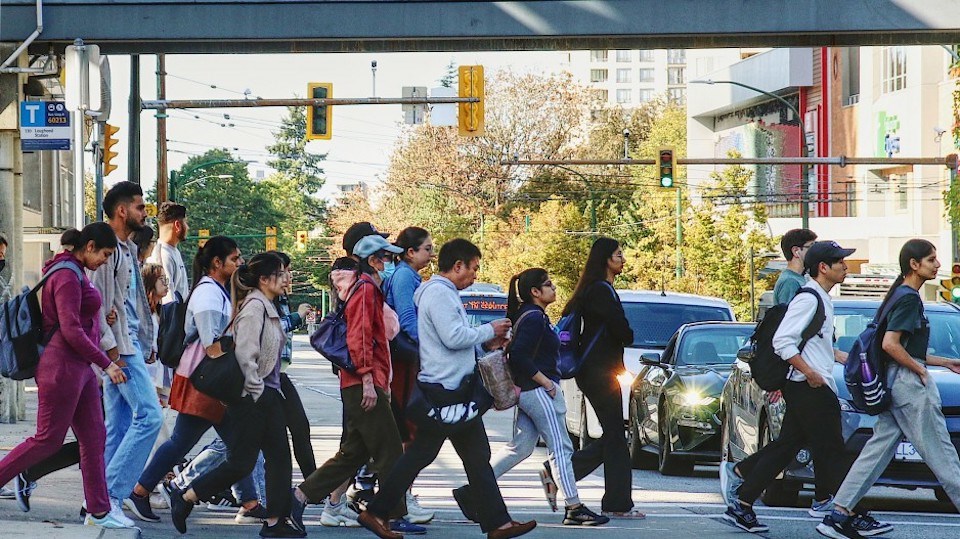Over the next decade, B.C.’s population, currently at 5.2 million, is forecast to grow by between 600,000 and one million, according to Statistics Canada.
About half of that growth can be expected to be concentrated in the Metro Vancouver region, which already has a population of close to 2.8 million – 53 per cent of B.C.’s total.
Metro Vancouver’s population is expected to swell by about 35,000 a year over the next three decades.
By 2030, that would increase the region’s population to 3.1 million.
Imagine what adding nearly 300,000 people to the region in less than a decade will mean for Metro Vancouver’s already congested roads, bridges, tunnels, buses, subways and ferries.
Public transit was a hot topic in the lead-up to municipal elections. In Surrey, Doug McCallum pledged to lobby for an Expo line extension from King George SkyTrain station to Newton if re-elected as the city’s mayor. And in Vancouver, TEAM for a Livable Vancouver campaigned on scrapping the proposed Millennium line extension to the University of British Columbia (UBC) to free up funding for four separate light-rail lines serving various parts of Vancouver.
Metro Vancouver’s 2040 regional growth strategy aims to rein in urban sprawl by concentrating residential growth in urban centres near public transit.
While the reasoning behind concentrating growth at transit hubs is sound, the reality is that population and job growth continue to sprawl east into places like Surrey and Langley, said Patrick Condon, professor of urban design at UBC.
“Once you get beyond Surrey, things are growing rapidly, up to three per cent a year, which is a lot,” Condon said. “That goes all the way out to Abbotsford and Chilliwack.”
Condon said regional public transit planning needs to move from a hub-and-spoke system, where all roads lead into Vancouver, towards a more network-based system.
“The growth is to the east, not in Vancouver, both for housing and jobs,” Condon said. “And I would say spend less money getting out to UBC and more money wisely south of the Fraser.”
When it comes to urban population growth, planners need to look not just at where people will live, but where they will work.
Many people who work in Vancouver can’t afford to live there, so they have to commute from places like Surrey, Langley and North Vancouver. Not surprisingly, those corridors are experiencing some of the worst transportation congestion problems and longest commute times.
A number of major transportation infrastructure projects underway are aimed at easing some of these chokepoints, including the replacement of the Pattullo Bridge, which is expected to be completed in 2024, and the Broadway extension of the Millennium line to Arbutus Street, which is expected to be in operation in 2025.
The B.C. government says it will replace the George Massey Tunnel with a new eight-lane tunnel that will include two lanes dedicated for public transit buses and dedicated cycling and walking paths. It aims to have the new tunnel built by 2030.
BC Liberal Party Leader Kevin Falcon has vowed to kill that project if the Liberals form the next government and revert back to the 10-lane bridge project that the BC NDP government killed.
One area of Metro Vancouver in dire need of more public transit is the Surrey-Langley region.
Surrey’s population, expected to exceed 600,000 in 2022, is projected to grow by about 120,000 over the next decade. But communities south of the Fraser River remain woefully underserved by public transit.
Surrey’s public transit deficit will be addressed somewhat with the new Surrey-Langley SkyTrain project, which will extend the Expo line 16 kilometres from King George station in Surrey to Langley Centre.
Construction is expected to start in 2024 and be completed in 2028. But that won’t do much for people who live in South Surrey and work elsewhere in Metro Vancouver.
In Vancouver, the biggest public transit project underway is the $2.8 billion Broadway extension, which will extend the Millennium line by 16 kilometres from VCC-Clark station to Arbutus Street.
The Broadway extension project is just one of the priorities for the first 10 years of TransLink’s Transport 2050 plan.
Other priorities for this decade include:
•more than doubling bus service in the region;
•a rapid transit connection to the North Shore;
•adding 170 kilometres of rapid transit trips;
•the Burnaby Mountain Gondola to Simon Fraser University;
•a Millennium line SkyTrain extension from Arbutus to UBC;
•possible SkyTrain extensions, including Newton in Surrey and Port Coquitlam; and
•450 kilometres of new traffic-separated cycling paths.
Condon thinks it’s a mistake to continue to build subways when light-rail transit (LRT) gets more bang for the buck and could serve a much wider geographic region. He said building subway lines in Metro Vancouver costs between $700 million and $1 billion per kilometre, whereas LRT can be built for $200 million per kilometre.
“You get five to 10 times more,” Condon said.
Outside of Metro Vancouver, the Ministry of Transportation and Infrastructure is working on widening the TransCanada Highway between Abbotsford and 264th Street in Langley, and recently agreed to fund a study for a new highway bypass in Kelowna.
As for B.C.’s liquid highways – ferries – 2022 underscored chronic staffing problems at BC Ferries that resulted in numerous cancellations and long wait times and lineups. The ferry corporation’s most immediate challenge will be addressing its workforce issues. Longer term, BC Ferries’ 12-year capital plan is focused on addressing peak ridership periods, which are mainly in the summer.
The plan includes:
•expanding BC Ferries’ two-ship operation on the Horseshoe Bay-Langdale route;
•increased sailings between Nanaimo and Metro Vancouver;
•adding a second Swartz Bay-to-Saltspring Island vessel; and
•a larger Denman-to-Hornby Island ferry.




